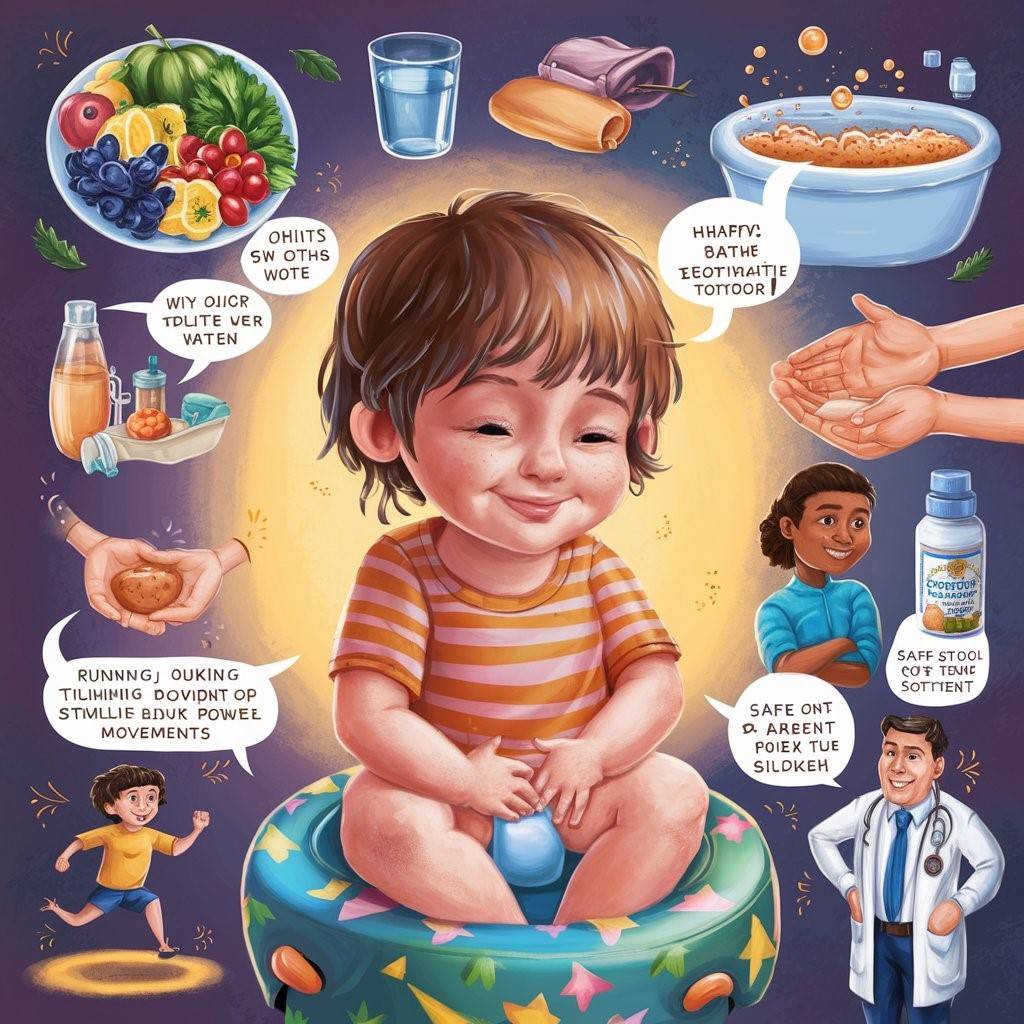Kids Constipation Problem: 10 Tips for Quick Relief!
Kids constipation problem? This guide offers 10 quick tips for relief like increasing fiber, fluids, and movement, plus advice on when to see a doctor for childhood constipation.
What is Kids Constipation Problem?
Kids constipation problems occur when a child has infrequent, hard, dry, or difficult bowel movements. It’s a very common issue, affecting up to 30% of children. While rarely caused by a serious condition, kids constipation problems can lead to stomach pain, withholding of bowel movements, and other issues if left untreated.
This in-depth guide covers everything parents need to know about identifying, treating, and preventing childhood constipation.
Signs Your Child is Constipated
Being aware of the signs can help you address a kids constipation problem before it becomes severe. Look for:
- Infrequent bowel movements (less than 3 per week in a child over 1 year old)
- Hard, dry, or pellet-like stools
- Straining, grunting, or pain while having a BM.
- Stomachache or cramps
- Decreased appetite.
- Soiling accidents (leakage)
Causes of Kids Constipation Problem
Many factors can contribute to childhood constipation, including:
- Low fiber diet
- Not drinking enough fluids
- Holding in bowel movements (often due to fear of pain from passing hard stools)
- Lack of physical activity
- Changes in routine like starting school.
- Illness or medication use
- Milk protein allergy or intolerance.
Kids constipation problem Quick Relief Tips

While chronic kids constipation problem may require treatment under a doctor’s guidance, try these tips first for occasional backup:
- Increase Fiber Intake – Offer fiber-rich foods like fruits, veggies, whole grains, beans, and bran. Good kid-friendly options include apples, pears, berries, leafy greens, whole grain bread and cereals, and bean dips.
- Boost Fluid Intake – Encourage your child to drink more water, milk, 100% fruit juices, and smoothies to soften stool.
- Try a Warm Bath – The warmth can help relax the colon and release the urge to go. Consider a 10–15-minute soak.
- Use Massage – Gently rub your child’s abdomen in a clockwise circular motion to help move things along.
- Get Moving – Physical activity like running, jumping, or playing can stimulate bowel movements.
- Give a Stool Softener – Look for child-safe, over-the-counter products with ingredients like docusate to ease hard stools.
- Be Patient but Positive – Don’t force or shame. Make potty time low-pressure and celebrate successes.
- Address Fears – If withholding due to pain, reassure your child and try distractions during potty breaks.
- Maintain Schedule – Sit them on the potty for 5-10 minutes after meals when the gastrocolic reflex is strongest.
- Call the Doctor – If none of the above provides relief within a week, it’s time to consult your pediatrician.
When to See a doctor
Most childhood constipation responds well to simple remedies, but severe or chronic cases require medical intervention. Seek care if your child experiences:
- Rectal bleeding
- Severe abdominal pain
- Vomiting
- Fever
- No bowel movement for more than 5 days in an infant or 3 weeks in a child
Your pediatrician can rule out underlying conditions, suggest prescription medications if needed, and guide dietary and lifestyle changes. Don’t let kids constipation problem go untreated, as it can lead to painful complications over time.
Prevention Tips
The best way to deal with kids constipation problem is to prevent it from occurring in the first place. Follow these tips:
Increase High Fiber Foods
Aim for your child to get the recommended daily fiber intake:
| Age | Fiber (grams) |
| 1-3 years | 19g |
| 4-8 years | 25g |
Good high-fiber options include:
- Fruits (berries, pears, apples, bananas)
- Veggies (broccoli, carrots, brussels sprouts)
- Whole grains (oats, whole wheat bread)
- Beans and lentils
Boost Fluid Intake
- Offer water, milk, and juices throughout the day.
- Infuse water with fruits for more flavor.
- Limit juice to 4-6oz per day for young kids.
- Transition to regular milk after age 2.
Encourage Movement
Regular physical activity helps keep the digestive system running smoothly.
- Aim for 60 minutes per day of active play.
- Take breaks for movement during long sedentary periods like school.
- Go for family walks or bike rides.
Develop a Routine
Having a consistent potty routine can “train” the body’s natural rhythms.
- Sit on the potty for 5-10 minutes after meals.
- Use a footstool for proper squatting position.
- Build in potty breaks during regular daily activities.
Respond Promptly
Don’t ignore signs that your child needs to poop. Holding it can trigger a cycle of reoccurring constipation.
Consider Supplements
If increasing fiber-rich foods isn’t enough, pediatrician-approved fiber gummies or powders can help meet your child’s daily needs.
Limit Binding Foods
Minimize foods that can contribute to constipation:
- Bananas
- Applesauce
- White bread/pasta
- Fast food
- Processed snacks
With some simple diet and lifestyle adjustments, most kids constipation problem can be managed at home. But don’t hesitate to loop in with your pediatrician if issues persist.
When to Call the Doctor
While not usually a cause for major concern, severe kids constipation problem warrants medical attention. Call your pediatrician right away if your child experiences:
- Rectal bleeding
- Fever
- Vomiting
- Abdominal pain so severe they can’t sit still
- No bowel movement for more than 3 days
Your doctor can evaluate for underlying conditions like a blockage, anorectal malformation, or Hirschsprung’s disease and recommend the next treatment steps.
Dealing with “Withholding”
One of the most common reasons for a recurring kids constipation problem is stool withholding, where a child holds in bowel movements often due to fear of pain from passing hard stools.
This can create a vicious cycle of increasing constipation, pain with BMs, and increased withholding. Over time it can negatively impact the nerves that control the rectum and bowels.
If your child is withholding, try not to get frustrated. Remain positive during potty times, offer distractions like books or tablets, and avoid punishments that create more anxiety around pooping.
Consistent use of stool softeners, fiber supplements, and behavior modifications under your pediatrician’s guidance can help break the withholding cycle.
When Home Remedies Aren’t Enough
For many kids, simple diet and routine adjustments relieve occasional kids constipation problem. But for others, home remedies may not provide lasting relief. Signs you may need additional treatment include:
- Constipation not responding after 1 week of fiber/fluid increases.
- Painful bowel movements
- Abdominal bloating or cramping
- Leakage or soiling accidents If your child experiences any of these, it’s time to consult your pediatrician. They may recommend one or more of the following treatment options:
Medications
- Over-the-counter osmotic laxatives like PEG, lactulose, or sorbitol to soften stool.
- Stimulant laxatives for short-term use when osmotic laxatives aren’t effective.
- Prescription medications like linaclotide if chronic constipation does not respond to other methods.
Enemas Generally reserved for cases of severe impaction, an enema can help clear hard, dry stool from the rectum to “reset” the system.
Biofeedback Training This helps retrain the muscles involved in the defecation process through monitoring of muscle activity.
Changes to Diet Your pediatrician may recommend:
- Further increasing fiber intake through supplements
- Limiting binding foods like bananas, rice, applesauce
- Ensuring adequate hydration
- Adding probiotic-rich foods like yogurt
Behavioural Techniques These can help overcome issues like stool withholding:
- Positive reinforcement for successful BMs
- Scheduled toileting timed with the body’s gastrocolic reflex.
- Creating a relaxing, routine-driven potty environment
In addition to medical guidance, be sure to rule out any potential sources of pain like fissures or hemorrhoids that could be prompting withholding behaviors.
With the right treatment plan, most children achieve durable relief from chronic childhood constipation within 3-6 months. Consistent follow-up is key to making any needed adjustments.
Managing Constipation in Infants
Kids constipation problem can strike at any age, even in exclusively breastfed babies. While infrequent, constipation can be particularly distressing for infants.
Signs of infant constipation include:
- Infrequent, hard bowel movements
- Excessive crying, arching back.
- Loss of appetite
- Abdominal swelling
- Blood in stool
Home remedies your pediatrician may recommend include:
- Giving extra water or fruit juices like prune or pear
- Infant massage and bicycle leg moves.
- Rectal thermometer stimulation
- Glycerin suppositories
Never give laxatives, enemas, or mineral oil to infants without your doctor’s approval, as these can be dangerous. See your pediatrician promptly if home techniques don’t provide relief within a few days.
Supporting a Child Through Constipation
Dealing with kids constipation problem can be stressful for children and parents alike. These tips can help:
- Reassure them it’s not their “fault” and that constipation is a common issue.
- Use positive reinforcement for successful BMs, not punishments.
- Accommodate potty breaks and dietary needs at school/daycare.
- Provide privacy, and comfort objects if desired during potty time.
- Distract with books, tablets, or toys to avoid holding/withholding.
- Build in extra cuddling, reading, and relaxation time during flare-ups
With patience and the right management plan, most children overcome constipation troubles. Don’t let it linger, as it can impact self-confidence and contribute to withholding cycles. Seek medical support any time kids constipation problem causes significant discomfort or disruption.
Frequently Asked Questions
How to treat child constipation?
Start with increasing high-fiber foods like fruits, veggies, whole grains, and beans. Also boosts fluid intake and physical activity. Over-the-counter stool softeners or laxatives can provide relief if dietary changes aren’t enough. See a pediatrician if home remedies don’t work within a week.
Why is my 5-year-old so constipated?
Common causes in this age group include not getting enough fiber and fluid, holding in bowel movements, lack of exercise, and significant changes in routine. An underlying condition could also be the culprit, so see your pediatrician for an evaluation.
What fruit is good for constipation?
High fiber fruits like berries, pears, apples, prunes, and raisins can help relieve and prevent constipation in kids. The fiber adds healthy bulk to stool while the fruits’ water content helps soften it as well.
What to eat during constipation?
Focus on high-fiber foods like fruits, veggies, beans, lentils, and whole grains. Good hydrating options include water, milk, herbal teas, and diluted 100% fruit juices. Also, get plenty of exercise. Avoid processed, low-fiber foods.
Conclusion
Kids constipation problem is an extremely common issue that most children experience at some point. While rarely dangerous if addressed promptly, it can lead to pain, withholding behaviours, and other complications when left untreated.
Start with simple, easy remedies like increasing fiber, fluids, movement and implementing a consistent potty routine. But don’t hesitate to contact your pediatrician if home approaches don’t bring lasting relief within a week. With their guidance on medications, supplements, behavioural techniques, or even biofeedback training when needed, the majority of kids find durable solutions.
The key is working to prevent kids constipation problem from becoming an ingrained issue. Addressing it consistently with patience, positive reinforcement, and medical oversight as needed can spare your child significant discomfort and get potty health back on track.



